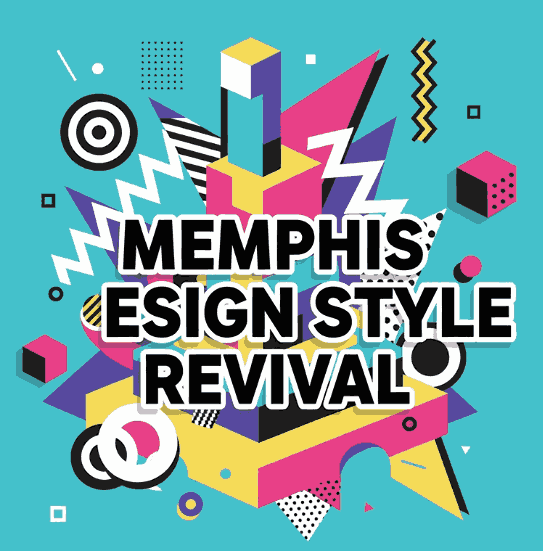
Table of Contents
- Introduction: What Is Memphis Design?
- The Origins of the Memphis Movement
- Why Memphis Design Is Making a Comeback
- Key Characteristics of the Memphis Style
- Applying Memphis Design in Modern Projects
- Best Fonts to Complement the Memphis Design Revival
- Final Thoughts
- References
1. Introduction: What Is Memphis Design Style Revival?
Memphis Design Style Revival is one of the most visually striking design movements in modern history. Characterized by bright colors, geometric shapes, and bold patterns, this 1980s style was a rebellion against the minimalist and functional design trends that dominated the era.
In recent years, the Memphis Design Revival has captured the attention of artists, designers, and brands looking to inject playfulness and creativity into their projects. Its unique combination of nostalgic aesthetics and modern versatility makes it perfect for digital art, branding, and typography-based compositions.

2. The Origins of the Memphis Design Style Revival
Movement
The Memphis Group was founded in Milan, Italy, in 1980 by the visionary designer Ettore Sottsass and a collective of young creatives. They aimed to challenge the conventions of modernism, which focused heavily on minimalism and practicality.
Instead, they introduced a design language filled with vibrant color palettes, asymmetry, and decorative chaos. Their work influenced not only furniture and architecture but also graphic design, fashion, and typography — industries that continue to celebrate Memphis-inspired creations today.
3. Why Memphis Design Style Revival Is Making a Comeback
The revival of Memphis design can be attributed to several cultural and aesthetic shifts:
- Nostalgia for the 80s and 90s: Retro styles are trending again, driven by digital media, music, and fashion industries that celebrate vintage vibes.
- Bold Visual Identity: In a digital world filled with minimalism, the Memphis style stands out — it’s daring, expressive, and instantly recognizable.
- Creative Freedom: Designers love its unrestricted approach. There are no rigid rules — you can mix colors, shapes, and fonts however you like.
- Social Media Influence: Platforms like Instagram and Pinterest thrive on eye-catching visuals, making Memphis-inspired art perfect for shareable content.
Brands like Apple, MTV, and even Gucci have embraced the Memphis aesthetic, showing that bold design can be both nostalgic and forward-thinking.
4. Key Characteristics of the Memphis Design Style Revival
Here are some essential features that define Memphis design:
- Vibrant Color Combinations: Bright pinks, yellows, blues, and reds dominate the palette.
- Geometric Patterns: Circles, triangles, zigzags, and squiggles are the visual trademarks of the style.
- Playful Shapes and Layouts: The style often breaks traditional design grids and embraces asymmetry.
- Layered Elements: Overlapping shapes, textures, and lines create depth and a sense of fun.
- Typography Variety: Contrasting fonts and sizes emphasize the design’s expressive nature.
Memphis design celebrates imperfection and chaos — qualities that make it timeless and adaptable in both digital and print media.
5. Applying Memphis Design Style Revival in Modern Projects
Incorporating Memphis elements into today’s creative projects can make your work visually distinct. Here’s how you can use it effectively:
- Branding and Logos: Combine bold geometric shapes with vivid colors for memorable brand marks.
- Website Design: Use asymmetrical layouts and color blocks to capture attention without overwhelming the user.
- Packaging Design: Memphis-style patterns can make products stand out on store shelves.
- Typography: Choose expressive fonts that match the style’s personality — playful, bold, and creative.
Whether you’re a graphic designer, content creator, or small business owner, Memphis design adds personality and nostalgia to any creative project.

6. Best Fonts to Complement the Memphis Design Style Revival
To achieve a perfect balance between retro and modern in your Memphis-inspired projects, choose fonts that are expressive yet readable. Here are some excellent font options from CalligraphyFonts.net that capture this aesthetic:
1. Classicly Font
A stylish display serif font that exudes retro flair. Perfect for Memphis-style posters, editorial titles, and packaging that needs a touch of vintage charm.
2. Mode Center Font
This modern display font is bold and clean, ideal for creating striking typographic compositions and digital layouts.
3. Hangstand Font
With its strong uppercase letters and artistic edge, Hangstand Font fits perfectly in branding and statement-based visuals.
4. Creatoria Font
An expressive display typeface with unique shapes that harmonize well with the geometric playfulness of Memphis design.
When combined with vibrant patterns and contrasting colors, these fonts can help you build an authentic Memphis-inspired identity for your creative works.
7. Final Thoughts
The Memphis Design Style Revival represents more than just a return to the 1980s — it’s a reawakening of creative freedom and self-expression. In an age where clean and minimal design often dominates, Memphis offers a joyful reminder that design can be fun, bold, and unapologetically colorful.
By pairing this aesthetic with expressive typefaces like Classicly, Mode Center, Hangstand, and Creatoria, designers can craft visuals that evoke both nostalgia and innovation.
Whether you’re redesigning your brand, creating digital art, or exploring new design trends, embracing Memphis design can help you stand out with confidence and creativity.
8. References
- The Spruce – What Is Memphis Design?
- HOMMÉS Studio – What Is Memphis Design Style And Why It Is Back
- Din Studio – Exploring Memphis Design: A Style That Makes a Comeback
- ArchDaily – Libertarian and Anti-functionalist: What Is the Memphis Design Movement?



